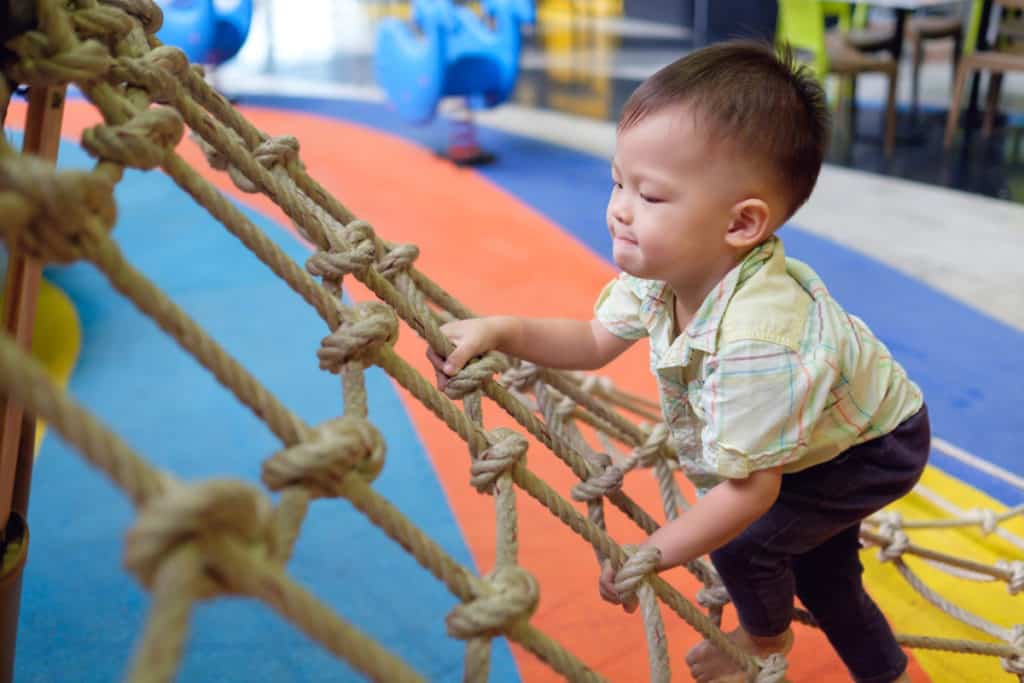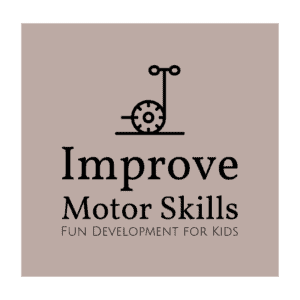I have written quite a lot about Pikler triangles as they have proven to be really good toys/tools to improve toddlers’ balance and climbing skills. While I give them a 100% thumbs-up, the downside of Piklers’ is that they are relatively expensive.
Fortunately, there are lots of free alternatives to replace the outcome a Pikler triangle offers. In fact, there are tons of climbing possibilities around you – just keep your eyes open and let your kid experiment and climb on everything they can.

And I’d like to emphasize the word ‘everything’ – it’s a common problem with parents to not let kids do certain things, without actually thinking through if it actually needs stopping… ‘Don’t climb on the couch!’ ‘Don’t climb that bench!’ ‘ Don’t do this or that!’. Just take a second and think through whether the action you are about to forbid is really potentially harmful for your kid or someone’s property, or will it instead improve a certain skill your child is trying to master. So I encourage you to take a step back and see if climbing that tree is actually that bad.
Anyway, here are 9 free alternatives to Pikler triangles that will give a nice boost to your kid’s climbing and balancing skills. Use each of them separately or combine them to build monstrous climbing frames. But keep in mind that kids learn best through play – don’t force your ideas on them too hard.
Free (or Really Cheap) Alternatives to Pikler Triangles
Cushions and Pillows
The easiest choice to encourage your toddler to start climbing is to use cushions and pillows. This is how our daughter did her first ‘vertical’ movements at around 6-7 months.
We were playing on a bed when suddenly magic happened. At one point, she started taking interest in one of the pillows and, while having a hard time coordinating her small hands and feet, she managed to climb on top of one. What a win 🙂
After that, we intentionally placed pillows on her path (on the bed, couch, floor) to encourage her to climb over them. Use regular soft pillows for an easy start and move on to harder couch cushions when your kid feels more comfortable on them.
Also, try building stairs from the harder cushions that lead to a couch or a bed. But make sure the structure is solid, and stay close-by to avoid accidents.
Your Body
This is by far the most ‘climbable’ thing in our apartment. Our daughter just loves climbing back and forth over us.
The cool thing here is that it’s so perfect for bonding with your little one. And you get to change your body positions to make it increasingly harder to climb over you.
This one was actually a life-saver when my wife got the flu while I was away and she was home alone with our daughter. Because she wasn’t feeling all that great, they couldn’t go to the playground or play any of their usual games. So she just laid down on the floor with our baby and she would just keep climbing back and forth over her and cuddling, and was perfectly happy to stay indoors.
A Mattress
Another ‘toy’ that we have used to encourage our daughter to climb, is a single mattress from our guest bedroom. Just place one end on the floor and the other on a bed or a couch to create a ramp for your kid. They’ll love climbing up and down on it.
A fun side-idea – try placing it at a steeper angle to build a slide for them.
Boxes-Boxes-Boxes!
Just like our cat, our daughter is just crazy about boxes. Whenever we buy something that comes in a large enough box that she can fit into, she will fit into it 🙂 She will climb into it, and back out again, back in, back out… This can go on for 10-20 minutes.
We have also encouraged her to take her toys into the box, which helps her improve her climbing skills even further as she’ll want to hold on to them until she is actually inside the box.
Stairs
If your kid is already climbing on stuff, you might want to introduce stairs to them. Instead of picking them up when going out, allow them to go down the stairs by themselves (feet and butt first). Always stay behind them for safety and assist if they feel uncertain.
With our daughter, we often climb the stairs for fun. She keeps pointing towards the stairs and once she gets down, she will start climbing up again. What a joy it is to see your kid being active 🙂
Ladder
A regular ladder is a great tool to boost your toddler’s climbing skills. Place it horizontally on the ground when your kid is still learning to climb and gradually increase the angle, by placing something under one side, as they develop. The rungs of a ladder are excellent small milestones to cover when babies first start taking an interest in climbing.
Ladders can be used both indoors as well as outdoors, depending on the size of your ladder. Our daughter’s first experience with a ladder was on a 10-foot (3-meter) construction ladder (horizontally on the ground, of course). She was about 12 months old and not walking yet but as soon as she saw the ladder on the ground, she wanted to climb on it. She kept going from one end to the other climbing over one rung at a time on all fours. And she was having so much fun!
Turn Furniture Upside Down
Another way of providing a cheap alternative to a Pikler triangle is by using various pieces of furniture and turning them on sides or upside down.
For example, take a chair and put it on its side. The legs of the chair are excellent obstacles to climb over. Older toddlers can try to climb over the side of the chair as well. Make sure it’s stable enough so the kids won’t hurt themselves.
If you have an armchair, ottoman, foot stool or anything else at home that your child can handle, turn it upside down and use that to introduce new surfaces and situations for your kid. The more varied their climbing experience is, the faster and better they develop their climbing and balancing skills.
DIY Climbing Board / Balancing Board
It just takes a larger sheet of plywood, some wooden blocks, sanding, and screws to easily build a climbing wall for your kids. If you have a toddler who is just learning to climb, then keep the board almost horizontally on the ground (e.g. place a couch cushion under one side). When your kid grows and learns, increase the angle (e.g. put one side on the couch).
Always make sure you stay with your kid when they are climbing on such unstable surfaces. If you want to increase the angle even more, attach it securely to a wall.
A bonus idea: screw a small wooden block under the board (in the center) and place the board on the ground, so that the block touches the ground and the board itself is afloat. When the kid climbs on the board, one side will touch the ground but as soon as they start moving on the board, the board will start moving as well. This makes balancing more diffcult and is good for practicing more climbing skills.
Public Playgrounds and Jungle Gyms
There are so many climbing options on different public playgrounds. An easy start could be climbing over the side of a sandbox or climbing up the stairs to a slide. A more experienced kid could try the more sophisticated climbing frames many playgrounds often have.
The bonus here is that there are other kids there and this could motivate your little one to try and imitate what they are doing.
Conclusion
You don’t necessarily need a Pikler triangle to allow your kid to practice climbing. Let your child experience free movement. Let them try different surfaces. Don’t always forbid them. Think through what is actually best for their development. And let them have fun 🙂
